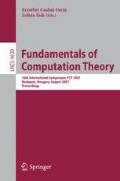Abstract
The Boolean network (BN) is a mathematical model of genetic networks. It is known that detecting a singleton attractor, which is also called a fixed point, is NP-hard even for AND/OR BNs (i.e., BNs consisting of AND/OR nodes), where singleton attractors correspond to steady states. Though a naive algorithm can detect a singleton attractor for an AND/OR BN in O(n 2n) time, no O((2 − ε)n) (ε> 0) time algorithm was known even for an AND/OR BN with non-restricted indegree, where n is the number of nodes in a BN. In this paper, we present an O(1.787n) time algorithm for detecting a singleton attractor of a given AND/OR BN, along with related results.
Access this chapter
Tax calculation will be finalised at checkout
Purchases are for personal use only
Preview
Unable to display preview. Download preview PDF.
References
Akutsu, T.: On finding attractors in Boolean Networks using SAT algorithms (manuscript)
Akutsu, T., Kuhara, S., Maruyama, O., Miyano, S.: A system for identifying genetic networks from gene expression patterns produced by gene disruptions and overexpressions. Genome Informatics 9, 151–160 (1998)
Akutsu, T., Miyano, S., Kuhara, S.: Inferring qualitative relations in genetic networks and metabolic pathways. Bioinformatics 16, 727–734 (2000)
Albert, R., Barabasi, A-L.: Dynamics of complex systems: Scaling laws for the period of Boolean networks. Physical Review Letters 84, 5660–5663 (2000)
Drossel, B., Mihaljev, T., Greil, F.: Number and length of attractors in a critical Kauffman model with connectivity one. Physical Review Letters 94, 88701 (2005)
Glass, L., Kauffman, S.A.: The logical analysis of continuous, nonlinear biochemical control networks. Journal of Theoretical Biology 39, 103–129 (1973)
Hirsch, E.A.: New worst-case upper bounds for SAT. Journal of Automated Reasoning 24, 397–420 (2000)
Huang, S.: Gene expression profiling, genetic networks, and cellular states: an integrating concept for tumorigenesis and drug discovery. Journal of Molecular Medicine 77(6), 469–480 (1999)
Iwama, K., Tamaki, S.: Improved upper bounds for 3-SAT. In: Proc. 15th ACM-SIAM Symposium on Discrete Algorithms, p. 328 (2004)
Kauffman, S.: Metabolic stability and epigenesis in randomly connected genetic nets. Journal of Theoretical Biology 22, 437–467 (1968)
Kauffman, S.: The Origin of Order: Self-organization and selection in evolution. Oxford Univ. Press, New York (1993)
Kauffman, S., Peterson, C., Samuelsson, B., Troein, C.: Random Boolean network models and the yeast transcriptional network. Proceedings of the National Academy of Sciences 100(25), 14796–14799 (2003)
Leone, M., Pagnani, A., Parisi, G., Zagordi, O.: Finite size corrections to random Boolean networks, cond-mat/0611088 (2006)
Milano, M., Roli, A.: Solving the satisfiability problem through Boolean networks. In: Lamma, E., Mello, P. (eds.) AI*IA 99:Advances in Artificial Intelligence. LNCS (LNAI), vol. 1792, pp. 72–93. Springer, Heidelberg (2000)
Mochizuki, A.: An analytical study of the number of steady states in gene regulatory networks. J. Theoret. Biol. 236, 291–310 (2005)
Samuelsson, B., Troein, C.: Superpolynomial growth in the number of attractors in Kauffman networks. Physical Review Letters 90, 98701 (2003)
Shmulevich, I., Kauffman, S.: Activities and sensitivities in Boolean network models. Physical Review Letters 93(4), 48701 (2004)
Somogyi, R., Sniegoski, C.A.: Modeling the complexity of genetic networks: Understanding multigenic and pleitropic regulation. Complexity 1(6), 45–63 (1996)
Yamamoto, M.: An improved Õ (1.234m)-time deterministic algorithm for SAT. In: Proc. International Symposium on Algorithms and Computation, pp. 644–653 (2005)
Zhang, S., Hayashida, M., Akutsu, T., Ching, W., Ng, M.K.: Algorithms for finding small attractors in Boolean networks. EURASIP Journal on Bioinformatics and Systems Biology (in press)
Author information
Authors and Affiliations
Editor information
Rights and permissions
Copyright information
© 2007 Springer-Verlag Berlin Heidelberg
About this paper
Cite this paper
Tamura, T., Akutsu, T. (2007). An O(1.787n)-Time Algorithm for Detecting a Singleton Attractor in a Boolean Network Consisting of AND/OR Nodes. In: Csuhaj-Varjú, E., Ésik, Z. (eds) Fundamentals of Computation Theory. FCT 2007. Lecture Notes in Computer Science, vol 4639. Springer, Berlin, Heidelberg. https://doi.org/10.1007/978-3-540-74240-1_43
Download citation
DOI: https://doi.org/10.1007/978-3-540-74240-1_43
Publisher Name: Springer, Berlin, Heidelberg
Print ISBN: 978-3-540-74239-5
Online ISBN: 978-3-540-74240-1
eBook Packages: Computer ScienceComputer Science (R0)

